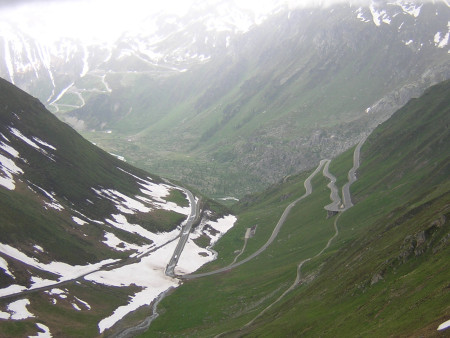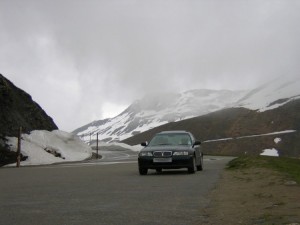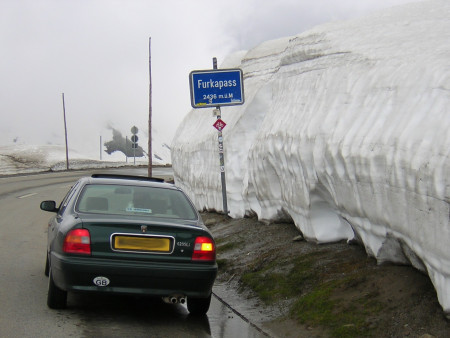10-Second Guide: Mountain Driving for Motorhomers
A great many drivers who have always lived (and driven) in the UK will never have driven up (or down) any kind of proper mountain roads.
At least, not the kind of miles long, deceptively-steep mountain roads that you can encounter in continental Europe. The reason for this is simple – we don’t have anything to equal the Alps, the Dolomites or the Pyrenees (and many more).

- This picture was taken from the same road, further up…
Yet if you hire a motorhome to go on holiday to Europe, these are exactly the kinds of roads you might encounter – in a vehicle much larger and heavier than your usual car.
The other problem is that many younger drivers have never driven older vehicles – the ones with poor brakes that forced drivers to learn about engine braking. Most modern cars allow you to get away with ‘driving on your brakes’ on UK roads – our roads are either not steep enough or not long enough to cause the dreaded brake fade.
(Brake fade is the result of brakes which have overheated and ceased to be effective. The result is that you don’t stop as quickly as normal – or even at all…)
 The result of all of this is that when you first encounter proper mountain roads, it can be a bit daunting. With sheer drops on one side, a wall of rock on the other and seemingly neverending hairpin bends, it’s not an environment that forgives any mistakes.
The result of all of this is that when you first encounter proper mountain roads, it can be a bit daunting. With sheer drops on one side, a wall of rock on the other and seemingly neverending hairpin bends, it’s not an environment that forgives any mistakes.
Add in the fact that you might be driving a large hired motorhome for the first time and the result can be seriously scary. It doesn’t need to be.
People have been driving cars, motorhomes, buses and lorries up and down mountain roads for years. All that’s required is a bit of care and the correct method.
Here’s a 10-second guide to mountain driving:
- Go down a mountain road in the same gear (or one lower) than you went up it
- Let the revs rise when descending – higher revs will slow the vehicle without the use of the brakes. It won’t harm the engine as long as you keep the revs in the green zone on the rev counter.
- When you do need to brake, do so in short, firm bursts of perhaps 5-10 seconds – then release the brakes and allow them to cool again.
- Don’t leave your foot lightly on the brake the whole way down the hill – this is a recipe for overheating brakes as they won’t get a chance to cool down between uses
- If you are on a road with hairpins, aim to come almost completely to a stop just before each bend. You may need to stop if something large is coming the other way and this approach will set you up safely for the bend and the next stretch – try not to brake too much between bends
- Ignore the people queuing up behind you. They aren’t responsible for your passengers’ safety. You are.
Although I was inspired to write this post by this very useful thread on the Motorhome Facts forum, I can personally confirm that this approach works well, having used it successfully on some of the steepest roads in the Alps and Pyrenees.
Get it right, and moutain driving is a terrific buzz – and enables you to see some of the finest views in the world. Once you’ve driven a few Alpine passes, ‘ordinary’ roads never seem the same again! Here’s a snap of my old car at the top of the Furka Pass in the Swiss Alps – 2,436m above sea level. Despite the snow, it was late June!

- 2,436m above sea level at the top of the Furka Pass in Switzerland
P.S. If you think I am exaggerating the risks of mountain driving, remember that a motorhome is not a car – it is a commercial vehicle. It probably weighs 2-3 times as much as your car and takes a lot more effort to stop. It is also less stable and forgiving on tight bends.

Pingback: Austria & The Grossglockner Pass – Germany 2009 - Motorhome Planet